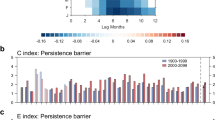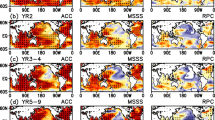Abstract
The tropical Pacific has begun to experience a new type of El Niño, which has occurred particularly frequently during the last decade, referred to as the central Pacific (CP) El Niño. Various coupled models with different degrees of complexity have been used to make real-time El Niño predictions, but high uncertainty still exists in their forecasts. It remains unknown as to how much of this uncertainty is specifically related to the new CP-type El Niño and how much is common to both this type and the conventional Eastern Pacific (EP)-type El Niño. In this study, the deterministic performance of an El Niño–Southern Oscillation (ENSO) ensemble prediction system is examined for the two types of El Niño. Ensemble hindcasts are run for the nine EP El Niño events and twelve CP El Niño events that have occurred since 1950. The results show that (1) the skill scores for the EP events are significantly better than those for the CP events, at all lead times; (2) the systematic forecast biases come mostly from the prediction of the CP events; and (3) the systematic error is characterized by an overly warm eastern Pacific during the spring season, indicating a stronger spring prediction barrier for the CP El Niño. Further improvements to coupled atmosphere–ocean models in terms of CP El Niño prediction should be recognized as a key and high-priority task for the climate prediction community.
摘要
El Niño作为全球最显著的年际变化信号, 对全球气候和环境均有着重要影响。近年来, 因其最大的年际异常信号主要集中在中太平洋区域, 且出现频率明显增加, 一种新的中太平洋型(CP型)El Niño现象引起了广泛的关注。过去研究主要集中在区分新的CP型El Niño事件与传统的东太平洋型(EP型)El Niño事件对全球各个区域不同的影响, 但是对于两类El Niño事件预测技巧存在的差异及其原因并未给出较好的解释。中国科学院大气物理研究所郑飞研究员和美国加州大学欧文分校Jin-Yi Yu教授, 基于大气所ENSO集合预测系统检验1950年以来的El Niño事件预测水平, 合作发现两类El Niño事件在预测技巧上存在着明显差异, 即系统对CP型El Niño事件的预测能力相比EP型事件明显偏弱。进一步的分析发现, CP型事件预测技巧偏弱有两个可能的原因制约: (1) 模型的预测偏差主要来源于其对CP型El Niño事件的预测; (2) 这一预测偏差主要体现为对CP型El Niño事件预测的春季暖偏差, 同时也与CP型事件的“春季预报障碍”更严重紧密联系。
Similar content being viewed by others
References
Ashok, K., and T. Yamagata, 2009: Climate change: The El Niño with a difference. Nature, 461, 481–484, doi: 10.1038/461481a.
Ashok, K., S. K. Behera, S. A. Rao, H. Y. Weng, and T. Yamagata, 2007: El Niño Modoki and its possible teleconnection. J. Geophys. Res., 112, C11007, doi: 10.1029/2006JC003798.
Barnston, A. G., M. K. Tippett, M. L. L’Heureux, S. H. Li, and D. G. DeWitt, 2012: Skill of real-time seasonal ENSO model predictions during 2002–11: Is our capability increasing? Bull. Amer. Meteor. Soc., 93, 631–651, doi: 10.1175/BAMSD-11-00111.1.
Chen, D. K., M. A. Cane, A. Kaplan, S. E. Zebiak, and D. J. Huang, 2004: Predictability of El Niño over the past 148 years. Nature, 428, 733–736, doi: 10.1038/nature02439.
Delecluse, P., M. K. Davey, Y. Kitamura, S. G. H. Philander, M. Suarez, and L. Bengtsson, 1998: Coupled general circulation modeling of the tropical Pacific. J. Geophys. Res., 103, 14 357–14 373, doi: 10.1029/97JC02546.
Duan, W. S., and P. Zhao, 2015: Revealing the most disturbing tendency error of Zebiak-Cane model associated with El Niño predictions by nonlinear forcing singular vector approach. Climate Dyn., 44, 2351–2367, doi: 10.1007/s00382-014-2369-0.
Fang, X.-H., F. Zheng, and J. Zhu, 2015: The cloud radiative effect when simulating strength asymmetry in two types of El Niño events using CMIP5 models. J. Geophys. Res., 120(6), 4357–4369, doi: 10.1002/2014JC010683.
Feng, L. S., F. Zheng, J. Zhu, and H. W. Liu, 2015: The role of stochastic model error perturbations in predicting the 2011/12 double-dip La Niña. SOLA, 11, 65–69, doi: 10.2151/sola.2015-014.
Imada, Y., H. Tatebe, M. Ishii, Y. Chikamoto, M. Mori, M. Arai, M. Watanabe, and M. Kimoto, 2015: Predictability of two types of El Niño assessed using an extended seasonal prediction system by MIROC. Mon. Wea. Rev., 143, 4597–4617, doi: 10.1175/MWR-D-15-0007.1
Jeong, H.-I., and Coauthors, 2012: Assessment of the APCC coupled MME suite in predicting the distinctive climate impacts of two flavors of ENSO during boreal winter. Climate Dyn., 39, 475–493, doi: 10.1007/s00382-012-1359-3.
Jin, E. K., and Coauthors, 2008: Current status of ENSO prediction skill in coupled ocean-atmosphere models. Climate Dyn., 31(6), 647–664, doi: 10.1007/s00382-008-0397-3.
Kao, H.-Y., and J.-Y. Yu, 2009: Contrasting eastern-Pacific and central-Pacific types of ENSO. J. Climate, 22, 615–632, doi: 10.1175/2008JCLI2309.1.
Karspeck, A. R., A. Kaplan, and M. A. Cane, 2006: Predictability loss in an intermediate ENSO model due to initial error and atmospheric noise. J. Climate, 19(15), 3572–3588, doi: 10.1175/JCLI3818.1.
Keenlyside, N., and R. Kleeman, 2002: Annual cycle of equatorial zonal currents in the Pacific. J. Geophys. Res., 107, 3093, doi: 10.1029/2000JC000711.
Kirtman, B. P., J. Shukla, M. Balmaseda, N. Graham, C. Penland, Y. Xue, and S. Zebiak, 2001: Current status of ENSO forecast skill: A report to the Climate Variability and Predictability (CLIVAR) Working Group on Seasonal to Interannual Prediction. WCRP Informal Report No. 23/01, 31pp.
Latif, M., and Coauthors, 1998: A review of the predictability and prediction of ENSO. J. Geophys. Res., 103(C7), 14 375–14 393, doi: 10.1029/97JC03413.
Luo, J.-J., C.-X. Yuan, W. Sasaki, Y. Masumoto, T. Yamagata, J.-Y. Lee, and S. Masson, 2016: Current status of intraseasonalseasonal-to-interannual prediction of the Indo-Pacific climate. The Indo-Pacific Climate Variability and Predictability, T. Yamagata, and S. Behera, Eds., The World Scientific Publisher, doi: 10.1142/97898146966230003.
McPhaden, M. J., and X. R. Yu, 1999: Equatorial waves and the 1997-98 El Niño. Geophys. Res. Lett., 26, 2961–2964, doi: 10.1029/1999GL004901.
McPhaden, M. J., and Coauthors, 1998: The tropical ocean-global atmosphere observing system: A decade of progress. J. Geophys. Res., 103, 14 169–14 240, doi: 10.1029/97JC02906.
McPhaden, M. J., S. E. Zebiak, and M. H. Glantz, 2006: ENSO as an integrating concept in earth science. Science, 314, 1740–1745, doi: 10.1126/science.1132588.
McPhaden, M. J., T. Lee, and D. McClurg, 2011: El Niño and its relationship to changing background conditions in the tropical Pacific Ocean. Geophys. Res. Lett., 38, L15709, doi: 10.1029/2011GL048275.
Moore, A. M., and R. Kleeman, 1996: The dynamics of error growth and predictability in a coupled model of ENSO. Quart. J. Roy. Meteor. Soc., 122, 1405–1446, doi: 10.1002/qj.49712253409.
Picaut, J., E. Hackert, A. J. Busalacchi, R. Murtugudde, and G. S. E. Lagerloef, 2002: Mechanisms of the 1997-1998 El Niño-La Niña, as inferred from space-based observations. J. Geophys. Res., 107, 3037, doi: 10.1029/2001JC000850.
Ren, H.-L., and F.-F. Jin, 2011: Niño indices for two types of ENSO. Geophys. Res. Lett., 38, L04704, doi: 10.1029/2010GL046031.
Röckner, E., and Coauthors, 1996: The atmospheric general circulation model ECHAM-4: Model description and simulation of present-day climate. Report No. 218, Max-Planck-Institut für Meteorologie, Hamburg, 90pp.
Schneider, E. K., B. P. Kirtman, D. G. DeWitt, A. Rosati, L. Ji, and J. J. Tribbia, 2003: Retrospective ENSO forecasts: Sensitivity to atmospheric model and ocean resolution. Mon. Wea. Rev., 131, 3038–3060, doi: 10.1175/1520-0493(2003)131<3038:REFSTA>2.0.CO;2.
Smith, T. M., R. W. Reynolds, T. C. Peterson, and J. Lawrimore, 2008: Improvements to NOAA’s historical merged land-ocean surface temperature analysis (1880-2006). J. Climate, 21, 2283–2296, doi: 10.1175/2007JCLI2100.1.
Wang, W. Q., M. Y. Chen, and A. Kumar, 2010: An assessment of the CFS real-time seasonal forecasts. Wea. Forecasting, 25, 950–969, doi: 10.1175/2010WAF2222345.1.
Webster, P. J., and S. Yang, 1992: Monsoon and ENSO: Selectively interactive systems. Quart. J. Roy. Meteor. Soc., 118, 877–926.
Yang, S., and X. W. Jiang, 2014: Prediction of eastern and central Pacific ENSO events and their impacts on East Asian climate by the NCEP Climate Forecast System. J. Climate, 27, 4451–4472, doi: 10.1175/JCLI-D-13-00471.1.
Yeh, S.-W., J.-S. Kug, and S.-I. An, 2014: Recent progress on two types of El Niño: Observations, dynamics, and future changes. Asia-Pac. J. Atmos. Sci., 50, 69–81.
Yu, J. Y., and H. Y. Kao, 2007: Decadal changes of ENSO persistence barrier in SST and ocean heat content indices: 1958-2001. J. Geophys. Res., 112, D13106, doi: 10.1029/2006JD007654.
Yu, J.-Y., and S. T. Kim, 2013: Identifying the types of major El Niño events since 1870. International Journal of Climatology, 33, 2105–2112, doi: 10.1002/joc.3575.
Yu, J.-Y., H.-Y. Kao, and T. Lee, 2010: Subtropics-related Interannual sea surface temperature variability in the central equatorial Pacific. J. Climate, 23, 2869–2884, doi: 10.1175/2010JCLI3171.1.
Yu, J.-Y., Y. H. Zou, S. T. Kim, and T. Lee, 2012: The changing impact of El Niño on US winter temperatures. Geophys. Res. Lett., 39, L15702, doi: 10.1029/2012GL052483.
Yu, J.-Y., X. Wang, S. Yang, H. Paek, and M. Chen, 2017: The changing El Niño–Southern Oscillation and associated climate extremes. Climate Extremes: Patterns and Mechanisms, S. Wang et al., Eds., John Wiley & Sons, Inc., Hoboken, NJ, USA, 1–38 pp, doi: 10.1002/9781119068020.ch1.
Zhang, R.-H., S. E. Zebiak, R. Kleeman, and N. Keenlyside, 2005: Retrospective El Niño forecasts using an improved intermediate coupled model. Mon. Wea. Rev., 133, 2777–2802, doi: 10.1175/MWR3000.1.
Zheng, F., and J. Zhu, 2008: Balanced multivariate model errors of an intermediate coupled model for ensemble Kalman filter data assimilation. J. Geophys. Res., 113, C07002, doi: 10.1029/2007JC004621.
Zheng, F., and J. Zhu, 2010a: Coupled assimilation for an intermediated coupled ENSO prediction model. Ocean Dyn., 60, 1061–1073, doi: 10.1007/s10236-010-0307-1.
Zheng, F., and J. Zhu, 2010b: Spring predictability barrier of ENSO events from the perspective of an ensemble prediction system. Global and Planetary Change, 72, 108–117, doi: 10.1016/j.gloplacha.2010.01.021.
Zheng, F., and R.-H. Zhang, 2012: Effects of interannual salinity variability and freshwater flux forcing on the development of the 2007/08 La Niña event diagnosed from Argo and satellite data. Dyn. Atmos. Oceans, 57, 45–57, doi: 10.1016/j.dynatmoce.2012.06.002.
Zheng, F., and R.-H. Zhang, 2015: Interannually varying salinity effects on ENSO in the tropical Pacific: A diagnostic analysis from Argo. Ocean Dynamics, 65(5), 691–705, doi: 10.1007/s10236-015-0829-7.
Zheng, F., and J. Zhu, 2015: Roles of initial ocean surface and subsurface states on successfully predicting 2006-2007 El Niño with an intermediate coupled model. Ocean Science, 11, 187–194, doi: 10.5194/os-11-187-2015.
Zheng, F., and J. Zhu, 2016: Improved ensemble-mean forecasting of ENSO events by a zero-mean stochastic error model of an intermediate coupled model. Climate Dyn., 47, 3901–3915, doi: 10.1007/s00382-016-3048-0.
Zheng, F., J. Zhu, R.-H. Zhang, and G.-Q. Zhou, 2006: Ensemble hindcasts of SST anomalies in the tropical Pacific using an intermediate coupled model. Geophys. Res. Lett., 33, L19604, doi: 10.1029/2006GL026994.
Zheng, F., J. Zhu, and R.-H. Zhang, 2007: The impact of altimetry data on ENSO ensemble initializations and predictions. Geophys. Res. Lett., 34, L13611, doi: 10.1029/2007GL030451.
Zheng, F., J. Zhu, H. Wang, and R.-H. Zhang, 2009a: Ensemble hindcasts of ENSO events over the past 120 years using a large number of ensembles. Adv. Atmos. Sci., 26(2), 359–372, doi: 10.1007/s00376-009-0359-7.
Zheng, F., H. Wang, and J. Zhu, 2009b: ENSO ensemble prediction: Initial error perturbations vs. model error perturbations. Chinese Science Bulletin, 54, 2516–2523, doi: 10.1007/s11434-009-0179-2.
Zheng, F., R.-H. Zhang, and J. Zhu, 2014a: Effects of interannual salinity variability on the barrier layer in the western-central equatorial Pacific: A diagnostic analysis from Argo. Adv. Atmos. Sci., 31(3), 532–542, doi: 10.1007/s00376-013-3061-8.
Zheng, F., X.-H. Fang, J.-Y. Yu, and J. Zhu, 2014b: Asymmetry of the Bjerknes positive feedback between the two types of El Niño. Geophys. Res. Lett., 41, 7651–7657, doi: 10.1002/2014GL062125.
Zheng, F., X.-H. Fang, J. Zhu, J.-Y. Yu, and X.-C. Li, 2016: Modulation of Bjerknes feedback on the decadal variations in ENSO predictability. Geophys. Res. Lett., 43, 12 560–12 568, doi: 10.1002/2016GL071636.
Zhu, J. S., B. H. Huang, R.-H. Zhang, Z.-Z. Hu, Arun Kumar, M. A. Balmaseda, L. Marx, and J. L. Kinter III, 2014: Salinity anomaly as a trigger for ENSO events. Scientific Reports, 4, 6821, doi: 10.1038/srep06821.
Acknowledgements
The authors wish to thank the two anonymous reviewers for their very helpful comments and suggestions. This work was supported by the National Program for Support of Top-notch Young Professionals, and the National Natural Science Foundation of China (Grant No. 41576019). J.-Y. YU was supported by the US National Science Foundation (Grant No. AGS-150514).
Author information
Authors and Affiliations
Corresponding author
Electronic supplementary material
376_2017_6324_MOESM1_ESM.pdf
Electronic Supplementary Material to: Contrasting the Skills and Biases of Deterministic Predictions for the Two Types of El Niño
Rights and permissions
About this article
Cite this article
Zheng, F., Yu, JY. Contrasting the skills and biases of deterministic predictions for the two types of El Niño. Adv. Atmos. Sci. 34, 1395–1403 (2017). https://doi.org/10.1007/s00376-017-6324-y
Received:
Revised:
Accepted:
Published:
Issue Date:
DOI: https://doi.org/10.1007/s00376-017-6324-y




